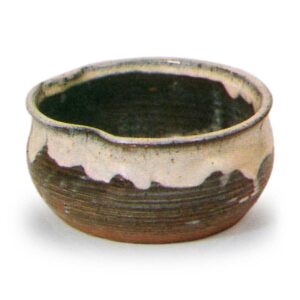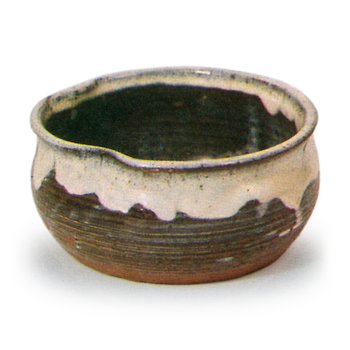
Umi-sagu glaze is a type of translucent glaze, and its main color is indigo-purple, but other colors such as blue, red, white, and black can also be found. The glaze method originally came from China, but the glaze tones used in Japan when it was first named “sea squirt glaze” were somewhat different from the translucent glaze used in many of today’s hibachi and other vessels. In other words, the description of a tea caddy in the “Chawaniki Bengokushu” (Tea Utensils Bengokushu) says, “The sea squirt from the foot of Mount Kinhua in Oshu is golden in color, and its glaze is similar to that of the one used today.
Sometimes, as seen in the mud of old Guangdong, the glaze is reddish-brown with flecks of indigo and light green, or has gold and silver flecks resembling oil droplets of tenmoku on a complex weeping glaze, which looks just like a live sea squirt. The origin of sea squirt glaze in China is the Shiwan kilns in Guangdong Province and the Dingshan kilns in Jiangsu Province, both of which invented a type of glaze tone while trying to imitate the leek green and moon white blue glaze color systems of the Ruzhou and Gyunzhou kilns that originated in the rain-over-temperate celadon of the Later Zhou Ciba kilns. Shiwan ware is called mud-glaze porcelain and dates back to the Song dynasty (960-1279). The purple-black glaze is a mixture of iron glaze and moon-white Nabeshima-S燒花(artistic design) dish glaze on a nearly stone-red body, with a moon-white rabbit thread pattern on the surface, and the glaze flow is distinctive. Ding Shan ware is said to have been created by Zi Ming in the Ming dynasty and is called Xuanqun porcelain. It is said to have been created by Zi Ming in the Ming dynasty and is called Xuanqun porcelain. The works of Ge Mingxiang and Ge Genxiang have been famous since ancient times. The blue, indigo, violet, and black colors of sea squirt glazes are mainly caused by iron salts, but copper salts are also used to some extent. In China and Japan, plants are used as a medium to induce permeability. In China, sea squirt glaze has long been derogatorily called “drowned jar color” and is used for cheap articles such as toilet bowls. In Japan, it is used for practical products such as braziers, and is most commonly produced in Shigaraki, Omi Prefecture (Shiga Prefecture), followed by Takatori, Kyushu, and other areas.



